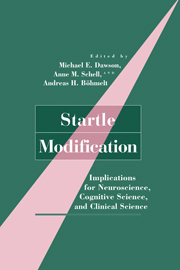Book contents
- Frontmatter
- Contents
- Contributors
- Preface
- Prologue: A Historical Note on the “Discovery” of Startle Modification
- 1 Startle Modification: Introduction and Overview
- PART I BASIC PARADIGMS, METHODS, AND PHENOMENA
- PART II PHYSIOLOGICAL MEDIATION OF STARTLE MODIFICATION
- PART III PSYCHOLOGICAL MEDIATION OF STARTLE MODIFICATION
- PART IV INDIVIDUAL DIFFERENCES AND STARTLE MODIFICATION
- PART V RELATIONSHIPS WITH OTHER PARADIGMS AND MEASURES
- 13 Behavioral Analogies of Short Lead Interval Startle Inhibition
- 14 Event-Related Potential Components and Startle
- 15 Startle Modification during Orienting and Pavlovian Conditioning
- References
- Author Index
- Subject Index
14 - Event-Related Potential Components and Startle
Published online by Cambridge University Press: 26 March 2010
- Frontmatter
- Contents
- Contributors
- Preface
- Prologue: A Historical Note on the “Discovery” of Startle Modification
- 1 Startle Modification: Introduction and Overview
- PART I BASIC PARADIGMS, METHODS, AND PHENOMENA
- PART II PHYSIOLOGICAL MEDIATION OF STARTLE MODIFICATION
- PART III PSYCHOLOGICAL MEDIATION OF STARTLE MODIFICATION
- PART IV INDIVIDUAL DIFFERENCES AND STARTLE MODIFICATION
- PART V RELATIONSHIPS WITH OTHER PARADIGMS AND MEASURES
- 13 Behavioral Analogies of Short Lead Interval Startle Inhibition
- 14 Event-Related Potential Components and Startle
- 15 Startle Modification during Orienting and Pavlovian Conditioning
- References
- Author Index
- Subject Index
Summary
ABSTRACT
This chapter considers how the P50, Nl, and P300 components of the auditory event-related brain potential (ERP) are related to startle. Although both blink and ERPs can be elicited by startling noises, blinks are muscular and ERPs are neural. Comparing startle blinks and ERPs reveals at what point the neural processes supporting them diverge. Each ERP component is evaluated against variables known to affect startle-stimulus intensity, stimulus rise time, habituation, and leading stimuli presented at both short and long lead intervals. ERPs recorded in startle modification paradigms suggest that the relationship between startle blinks and ERPs is weak. P50, Nl, and P300 are all inhibited by short lead intervals, but with different time courses from startle; only the fronto-central P300 is facilitated with long lead intervals.
Introduction
Psychophysiologists tend to specialize. Those who study event-related brain potentials (ERPs) usually do not study startle, perhaps because startle produces tremendous blinks and muscle contraction “artifacts” on the scalp, often much larger than ERPs. Yet startling stimuli elicit ERPs, and by comparing blinks and ERPs elicited by startling stimuli, we will learn about the dependence and interdependence of the neural pathways that support these two responses.
Developments Encouraging Study of Startle with ERPs
Two developments have encouraged looking at ERPs in conjunction with startle. First, parallels have been observed between startle modification and suppression of P50; schizophrenics have been found to differ from normals in both startle inhibition by lead stimuli at short lead intervals and P50 suppression (Chapter 11).
Information
- Type
- Chapter
- Information
- Startle ModificationImplications for Neuroscience, Cognitive Science, and Clinical Science, pp. 284 - 299Publisher: Cambridge University PressPrint publication year: 1999
Accessibility standard: Unknown
Why this information is here
This section outlines the accessibility features of this content - including support for screen readers, full keyboard navigation and high-contrast display options. This may not be relevant for you.Accessibility Information
- 5
- Cited by
